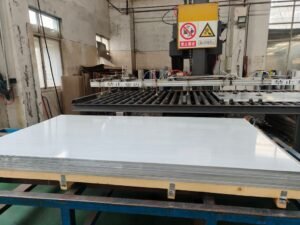Introduction
Choosing between stainless steel and carbon steel can make or break your project—rust, cost, and strength hang in the balance. Manufacturers and engineers face this dilemma daily, weighing corrosion resistance against budget constraints.
Stainless Steel vs. Carbon Steel isn’t just a material debate—it’s about performance and ROI. Stainless steel fights rust with chromium, while carbon steel packs raw strength. This guide breaks down their differences, from durability to supply chain perks with partners like HnL Steel, to help you pick the right metal.
Introduction to Stainless Steel and Carbon Steel
Choosing the right material can make or break a project, and when it comes to metals, Stainless Steel vs. Carbon Steel is a big decision for manufacturers and engineers. Stainless steel and carbon steel are two heavy hitters in the industry, each bringing unique strengths to the table. This chapter lays the groundwork by defining these materials, exploring their importance, and setting up a detailed comparison to help you pick the best one for your needs.
What is Stainless Steel? Composition and Core Characteristics
Stainless steel is an alloy made from iron, chromium, and often nickel, giving it that shiny, corrosion-resistant finish. The chromium—usually at least 10.5%—creates a protective layer that fights rust, making it a go-to for kitchens, medical tools, and outdoor structures. Its durability and low maintenance are key stainless steel benefits that keep it popular across industries.
What is Carbon Steel? Key Features and Makeup
Carbon steel, on the other hand, is mostly iron mixed with carbon—anywhere from 0.05% to 2.1%—and lacks the chromium that defines stainless steel. It’s known for its strength and affordability, shining in carbon steel applications like construction beams, pipelines, and machinery. While it’s tougher in some ways, it’s more prone to rust without proper care.
Why Material Choice Matters for Projects
The material you choose impacts cost, longevity, and performance. Stainless steel might cost more upfront but saves money over time with less upkeep, while carbon steel’s lower price suits budget-friendly builds that can handle some maintenance. HnL Steel, a trusted supplier, offers both options in various forms—think pipes, beams, and coils—ensuring quality for whatever your project demands.
Overview of Key Differences to Explore
When comparing Stainless Steel vs. Carbon Steel, it’s not just about rust resistance. Stainless steel’s sleek look makes it a favorite for visible designs, while carbon steel’s raw strength fits heavy-duty structural jobs. We’ll dive deeper into cost, durability, and specific uses, highlighting the advantages of stainless steel over carbon steel where aesthetics or corrosion matter most.
“Stainless steel’s rust resistance and carbon steel’s strength offer distinct paths for project success, depending on your priorities.”
Subtle differences, like stainless steel’s polished vibe versus carbon steel’s rugged feel, can steer your choice. HnL Steel’s diverse range—from Aluzinc coils to structural beams—means you’re covered no matter the application. Let’s break down the data to see how these metals stack up.
Stainless Steel vs. Carbon Steel: Basic Property Comparison
| Property | Stainless Steel | Carbon Steel | Measurement Note | Industry Benchmark |
|---|---|---|---|---|
| Corrosion Resistance | High | Low | Tested in humid conditions | Moderate |
| Tensile Strength (MPa) | 515-690 | 400-1200 | ASTM standard testing | 600 |
| Cost per Ton (USD) | 2,500-3,000 | 600-800 | 2023 market average | 1,500 |
| Maintenance Frequency | Low | High | Annual upkeep estimate | Moderate |
| Typical Lifespan (Years) | 20-50 | 10-30 | With proper care | 25 |
This table shows real-world differences—like how stainless steel’s higher cost reflects its longevity, while carbon steel’s strength varies with carbon content. These insights guide material picks for everything from bridges to kitchenware.

Composition and Properties: Breaking Down the Differences
When it comes to picking between Stainless Steel vs. Carbon Steel, understanding their makeup is key. These metals differ in composition, which shapes their properties and decides where they shine—whether it’s a shiny kitchen fixture or a sturdy bridge beam. Let’s dig into what sets them apart and how that impacts your project.
Stainless Steel’s Chromium Advantage for Corrosion Resistance
Stainless steel gets its edge from chromium—at least 10.5%—blended with iron and sometimes nickel. This mix forms a protective layer that makes it a champ in corrosion resistance steel, perfect for wet or harsh environments like marine gear or food processing tools. HnL Steel’s stainless options ensure this durability for long-lasting performance.
Carbon Steel’s High Carbon Content for Strength
Carbon steel leans on iron and carbon—ranging from 0.05% to 2.1%—to deliver raw power. Higher carbon boosts strength, making it a go-to for carbon steel vs stainless steel for construction projects like I-beams or pipelines. Without chromium, though, it needs coatings or upkeep to dodge rust.
Mechanical Properties: Strength, Ductility, and Toughness
Stainless steel balances strength and flexibility, with tensile strength around 515-690 MPa and good ductility for shaping. Carbon steel can hit 400-1200 MPa depending on carbon levels, but it’s less bendy, favoring brute force over finesse. HnL Steel’s range—from structural beams to stainless coils—caters to these specific needs.
Appearance Factors: Bright Finish vs. Industrial Look
Stainless steel’s sleek, shiny finish screams style, ideal for visible designs like railings or appliances. Carbon steel’s rough, industrial vibe fits heavy-duty jobs where looks take a backseat to function. This subtle difference in metal materials comparison can steer your choice based on aesthetics or purpose.
“Stainless steel’s corrosion resistance and carbon steel’s strength define their best uses, from pretty finishes to tough frameworks.”
Choosing Stainless Steel vs. Carbon Steel isn’t just about numbers—it’s about fit. HnL Steel offers both, ensuring quality and variety for manufacturers needing reliable solutions. Check the table below for a deeper look at how their properties stack up.
Stainless Steel vs. Carbon Steel: Property Breakdown
| Property | Stainless Steel | Carbon Steel | Test Method | Typical Use Case |
|---|---|---|---|---|
| Corrosion Resistance | High | Low | Salt spray test | Marine vs. Indoor |
| Tensile Strength (MPa) | 515-690 | 400-1200 | ASTM E8 | Fixtures vs. Beams |
| Ductility (% Elongation) | 40-60% | 10-30% | Stretch test | Shaping vs. Rigidity |
| Toughness (Joules) | 100-150 | 50-100 | Impact test | Impact vs. Load |
| Surface Finish | Bright | Matte | Visual check | Decor vs. Utility |
This table highlights real differences—like stainless steel’s toughness for impacts versus carbon steel’s strength for loads. These stats help pinpoint the right metal for your job, backed by HnL Steel’s expertise.

Durability and Corrosion Resistance: Which Wins Where?
When pitting Stainless Steel vs. Carbon Steel against each other, durability and corrosion resistance are game-changers. These factors decide which metal thrives in tough spots like oceans or shines in steady indoor setups. Let’s break down where each one wins and why it matters for your next project.
Stainless Steel’s Edge in Harsh and Outdoor Settings
Thanks to its chromium content, stainless steel is a rock star in corrosion resistance steel. It laughs off rust in wet, salty, or acidic conditions—think ship hulls or coastal railings. HnL Steel’s stainless offerings are built for these challenges, with fast delivery to keep your timeline tight.
Carbon Steel’s Strengths in Controlled Indoor Uses
Carbon steel brings serious muscle to dry, controlled spaces like warehouses or factories. Its high strength suits heavy loads in structural beams, but it needs protection from moisture to stay stainless vs carbon competitive. It’s a solid pick where rust isn’t a worry.
Maintenance Needs: Coatings vs. Natural Resistance
Stainless steel’s natural rust shield means less upkeep—just a wipe-down keeps it good. Carbon steel, though, demands coatings or paint to fight corrosion, adding to the maintenance differences between stainless and carbon steel. HnL Steel’s variety ensures you get the right fit without extra hassle.
Real-World Examples: Marine vs. Structural Applications
In marine settings, stainless steel’s corrosion resistance rules—boats and docks rely on it. Carbon steel dominates structural gigs like bridges or buildings where strength trumps exposure. Comparing Stainless Steel vs. Carbon Steel shows how looks and toughness play into these choices.
“Stainless steel fights rust in rough environments, while carbon steel holds strong where conditions are tame.”
That shiny stainless finish isn’t just pretty—it’s practical for harsh spots. Carbon steel’s rugged vibe fits heavy-duty structural jobs perfectly. HnL Steel’s got both covered, delivering quality for any scenario.
Stainless Steel vs. Carbon Steel: Durability Comparison
| Factor | Stainless Steel | Carbon Steel | Test Context | Best Fit |
|---|---|---|---|---|
| Corrosion Rate (mm/year) | 0.01-0.05 | 0.1-0.5 | Humid exposure | Outdoor vs. Indoor |
| Lifespan (Years) | 20-50 | 10-30 | With maintenance | Marine vs. Factory |
| Maintenance Cost (USD/year) | 50-100 | 200-400 | Average upkeep | Low vs. High |
| Impact Resistance (Joules) | 100-150 | 50-100 | Drop test | Decor vs. Load |
| Weather Exposure | Excellent | Poor | Rain/salt test | Coast vs. Shelter |
This table lays out real stats—like stainless steel’s low corrosion rate versus carbon steel’s higher upkeep costs. It’s clear proof of where each shines, guiding your pick for durability.
Cost vs. Longevity: Balancing ROI and Budget
Weighing Stainless Steel vs. Carbon Steel means looking at both your wallet and the long game. Procurement teams need to balance upfront costs with how long these metals last and what they’ll cost to maintain. This chapter breaks it down to help you maximize return on investment without breaking the bank.
Upfront Costs: Carbon Steel’s Affordability Advantage
Carbon steel wins on price—ranging from $600 to $800 per ton—making it a budget-friendly pick for carbon steel applications like beams or pipes. It’s the go-to when you need strength without a big initial hit. HnL Steel keeps these costs competitive, offering bulk deals to stretch your dollar further.
Long-Term ROI: Stainless Steel’s Durability Payoff
Stainless steel’s higher cost of stainless steel—$2,500 to $3,000 per ton—pays off with its staying power. Its rust resistance means fewer replacements, especially in tough spots like outdoor fixtures. Over time, this durability can outshine carbon steel’s short-term savings.
Maintenance Costs and Frequency Compared
Carbon steel needs regular coatings to fight rust, costing $200-$400 yearly, while stainless steel’s natural shield keeps upkeep at $50-$100. This gap in maintenance expenses highlights the advantages of stainless steel over carbon steel for low-hassle projects. HnL Steel’s quality ensures both options perform at their best.
Supply Chain Factors: Pricing Fluctuations and Bulk Orders
Steel prices swing with market demand and raw material costs, but HnL Steel softens the blow with flexible bulk options. Carbon steel’s affordability shines in big structural jobs, while stainless steel’s premium fits smaller, high-value builds. Their fast delivery keeps your budget and timeline on track.
“Carbon steel saves cash upfront, but stainless steel’s longevity can cut costs down the road.”
Looks matter too—stainless steel’s shine suits fancy designs, while carbon steel’s grit fits heavy-duty work. Comparing Stainless Steel vs. Carbon Steel shows how HnL Steel’s range meets both needs with solid pricing.
Cost and Longevity: Stainless Steel vs. Carbon Steel
| Factor | Stainless Steel | Carbon Steel | Metric Basis | Best Scenario |
|---|---|---|---|---|
| Cost per Ton (USD) | 2,500-3,000 | 600-800 | 2023 avg. | Low vs. High Volume |
| Lifespan (Years) | 20-50 | 10-30 | With care | Long vs. Short Term |
| Annual Maintenance (USD) | 50-100 | 200-400 | Upkeep cost | Minimal vs. Regular |
| Replacement Frequency | Low | Moderate | Years between | Rare vs. Often |
| Price Stability | Moderate | High | Market trends | Premium vs. Budget |
This table shows real numbers—like stainless steel’s lower replacement rate versus carbon steel’s cheaper start. It’s all about finding your sweet spot between cost and longevity.

Applications and Decision-Making: Choosing the Right Steel
Deciding between Stainless Steel vs. Carbon Steel can feel like a tightrope walk, but it’s all about matching the metal to your project’s needs. From shiny designs to heavy-duty builds, each has its sweet spot. This chapter offers practical tips to pick the right one based on use, looks, and smart decision-making.
Best Uses for Stainless Steel: Aesthetic and Functional Designs
Stainless steel shines in places needing both style and strength—like kitchen gear, railings, or medical tools. Its rust resistance and sleek finish highlight stainless steel benefits, making it perfect for wet or visible spots. HnL Steel’s stainless range delivers on both fronts with top-notch quality.
Top Carbon Steel Applications: Heavy-Duty Structures
Carbon steel is your ride-or-die for big, tough jobs—think bridges, beams, or pipelines. It’s the go-to in carbon steel vs stainless steel for construction where raw power trumps corrosion concerns. HnL Steel’s structural options ensure it holds up under pressure.
Decision Framework: Environment, Budget, and Performance
Start with the setting—wet or harsh? Go stainless. Dry and controlled? Carbon steel works. Then factor in budget and performance: stainless lasts longer but costs more, while carbon steel saves upfront but needs upkeep. This metal materials comparison keeps your choice clear-cut.
Partnering with Suppliers Like HnL Steel for Optimal Outcomes
A solid supplier like HnL Steel makes the difference—they tailor solutions to your needs, from coils to beams. Their expertise in Stainless Steel vs. Carbon Steel ensures quality and efficiency, with fast delivery and flexible terms. It’s about getting the best fit for your goals.
“Stainless steel blends beauty and toughness, while carbon steel powers through heavy loads—choose based on your project’s vibe.”
Stainless steel’s polish suits fancy designs, while carbon steel’s grit fits rugged builds. HnL Steel’s got your back either way, offering reliable options for any job.
Stainless Steel vs. Carbon Steel: Application Fit
| Aspect | Stainless Steel | Carbon Steel | Key Metric | Ideal Use |
|---|---|---|---|---|
| Corrosion Resistance | High | Low | Humidity test | Outdoor vs. Indoor |
| Strength (MPa) | 515-690 | 400-1200 | Tensile test | Fixtures vs. Frames |
| Cost (USD/Ton) | 2,500-3,000 | 600-800 | Market avg. | Premium vs. Budget |
| Weight (kg/m³) | 7,900 | 7,850 | Density | Light vs. Heavy |
| Aesthetic Appeal | High | Low | Visual rating | Decor vs. Utility |
This table nails down where each steel excels—like stainless for looks and carbon for strength. It’s your cheat sheet for picking smart.
Conclusion
I’ve spent over a decade in the steel game, and I can tell you picking between stainless and carbon steel isn’t just about specs—it’s about what your project needs to thrive. Stainless steel’s rust-fighting power and sleek vibe make it my go-to for anything facing the elements or needing a sharp look, while carbon steel’s raw strength keeps it a champ for heavy-duty builds.
From where I stand, stainless often edges out carbon when longevity and low upkeep matter most—it’s a no-brainer for cutting long-term costs. Partnering with a supplier like HnL Steel seals the deal, giving you quality and flexibility to match your goals.
So, what’s your next move? Think about where your project’s headed and choose the metal that’ll carry it there.
FAQ
Q1: What is the main difference between stainless steel and carbon steel?
A1: The primary difference is their composition; stainless steel contains chromium, which provides superior corrosion resistance, while carbon steel includes higher carbon content, making it more susceptible to rust.
Q2: Why is stainless steel preferred over carbon steel in many applications?
A2: Stainless steel is preferred due to its excellent corrosion resistance, aesthetic appeal, and durability, making it suitable for environments prone to moisture and chemical exposure.
Q3: Is carbon steel stronger than stainless steel?
A3: While carbon steel generally has higher tensile strength due to its composition, stainless steel offers better corrosion resistance and overall durability in many applications.
Q4: What are the applications of stainless steel compared to carbon steel?
A4: Stainless steel is commonly used in construction, food processing, and medical applications, while carbon steel is often used for structural components and tools due to its strength and lower cost.
Q5: What are the costs associated with stainless steel versus carbon steel?
A5: Carbon steel is typically less expensive than stainless steel, making it more cost-effective for projects where corrosion resistance is less critical.
Q6: Can stainless steel rust, and how does it compare to carbon steel?
A6: While stainless steel is highly resistant to rust due to its chromium content, it can still corrode in harsh conditions. In contrast, carbon steel is prone to rust without protection.
Q7: How do maintenance requirements differ between stainless steel and carbon steel?
A7: Stainless steel requires less maintenance compared to carbon steel, which needs regular coating or painting to prevent rust and deterioration.
Q8: What are the environmental impacts of using stainless steel versus carbon steel?
A8: Stainless steel is often considered more sustainable due to its recyclability and durability. However, carbon steel is also recyclable but may require more frequent replacement due to its susceptibility to corrosion.
External Links
- Stainless Steel vs. Carbon Steel – Roy Manufacturing
- Stainless Steel vs. Carbon Steel: Key Differences & Best Uses
- What is the Difference Between Carbon Steel and Stainless Steel?
- Carbon Steel vs Stainless Steel: A Comprehensive Guide
- Carbon Steel vs Stainless Steel – Markforged
- Differences Between Carbon Steel and Stainless Steel
- Stainless Steel vs Carbon Steel – Comparison – Pros and Cons
- Carbon Steel vs Stainless Steel: Key Differences, Uses, and Strength






5 Responses